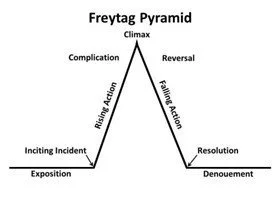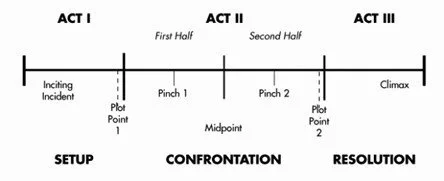6 Story Structures All Writer's Should Know
What kind of stories do you write? Romance? Action? Thrillers? Perhaps you are a versatile writer who dabbles in a little bit of everything.
No matter what genre you may write in, every story has something in common – they all have a basic structure. I’ve gone over the 8 elements of fiction writing, but it bears repeating that a story is essentially the sum of all its parts.
Much like a foundation in a house, story structure dictates the action that takes place and the path in which the story is told.
Narrative structure, or “story” structure, is how a story is put together, and there are many ways to parse out your tale. Some story structures play around with the timeline, while others emphasize plot mechanics.
Before we begin to dissect how you can adequately use story structure, it would help to go over some of the most popular story structures.
Including:
FREYTAG’S PYRAMID
Perhaps one of the most well-known story structures on this list, Freytag’s Pyramid was initially based on Greek tragedies, such as that of Sophocles. This structure is intended for the protagonist to go through a significant change, usually a tragic one, before a resolution is reached.
The structure is as followed:
Exposition: The world and its players are all established. Need-to-know information is given to the reader.
Inciting Incident: The action that kicks off the story takes place. (Ex. Harry Potter receives his first letter).
Rising Action: Stakes are established. The protagonist embarks on their journey.
Complication: Conflict is placed in the path of the primary goal.
Climax: The point at which everything changes. There is no turning back.
Reversal: The protagonist’s fortunes change – typically for the worse.
Falling Action: The aftermath of the climax is explored.
Resolution: The main story concludes.
Denouement: The reader is shown how the world has changed because of this story. This is not always done through an epilogue, though they are common.
Freytag’s Pyramid is still popular today and is a common structure in dramas.
THREE ACT STORY STRUCTURE
Often considered a classic, the prevalent Three Act Story structure is as simple as it is effective. The three main parts are the setup (where all the exposition is outlined), the confrontation, and the resolution.
Within each of these three sections are smaller subsets, with Act 2 containing most of the story’s action.
For instance, since Act 1 is the setup, you can expect to include a great deal of exposition, the inciting incident, and essentially steppingstones to the rest of the story.
All the conflict and every action made will lead to the final resolution and how the world changes.
THE HERO’S JOURNEY
True to its namesake, The Hero’s Journey is a storytelling structure modeled after heroes in mythology, from Odysseus to Luke Skywalker, and all the cool protagonists in between. It goes without saying that your hero can be any gender, but keep in mind that a hero’s journey typically follows the tale of one protagonist.
The Hero’s Journey comprises three main Acts; however, several mini moments will shape the Journey within those acts.
For instance, the hero will meet the mentor in Act I, and this person will give them information that will help them later in their journey. Within Act I there may be an additional obstacle or two that would change the choices the hero makes or sets up later skirmishes.
Throughout these acts this hero will also receive various tests, go through many obstacles, and ultimately, accomplish the goal they have set out to do, whether this means returning home after many years at sea, or something grander, such as saving the universe from the clutches of an evil foe.
It helps if you think of a hero’s journey as just that -a journey. There are significant moments that will shape the journey (the three acts), but the audience really remembers those smaller conflicts that happen in between.
IN MEDIA RES
This is one of my favorite story structures to use.
Latin for “in the midst of things,” In Media Res is a story that takes place in the middle of the action. For instance, your story may open during a gunfight or when your character is physically running away from danger.
This increases the action, pacing and gives your reader a reason to want to know what happens next.
The key for this story structure is to learn out to dole out need-to-know information to the reader. You can do so through dialogue, additional action, or through minor exposition.
This is a more challenging story structure to the right but works very well for almost all genres
The Seven-Point Story structure is similar to the Hero’s Journey because of many components to the narrative arc.
However, unlike the Hero’s Journey, there are no predefined plot points that you need to use, such as no mentor that every story must have.
Instead of specific plot points, the Seven Point Story Structure has the story “pinches” and “plot points.”
These are the moments when conflict happens (a pinch) or the reaction and effects of said conflict.
Like In Media Res, the Seven Point Story Structure works well for all genres.
There is no right or wrong story structure that you can use for your novel and in fact, there are many more than what is listed above.
The goal is to find the one that best tells your story.
Consider your story’s plot, its genre, the main characters, etc. You can also try out different stories to determine which one works best for you.


































Learn how to write believable horror protagonists readers care about, with tips and examples from horror films and classic literature.